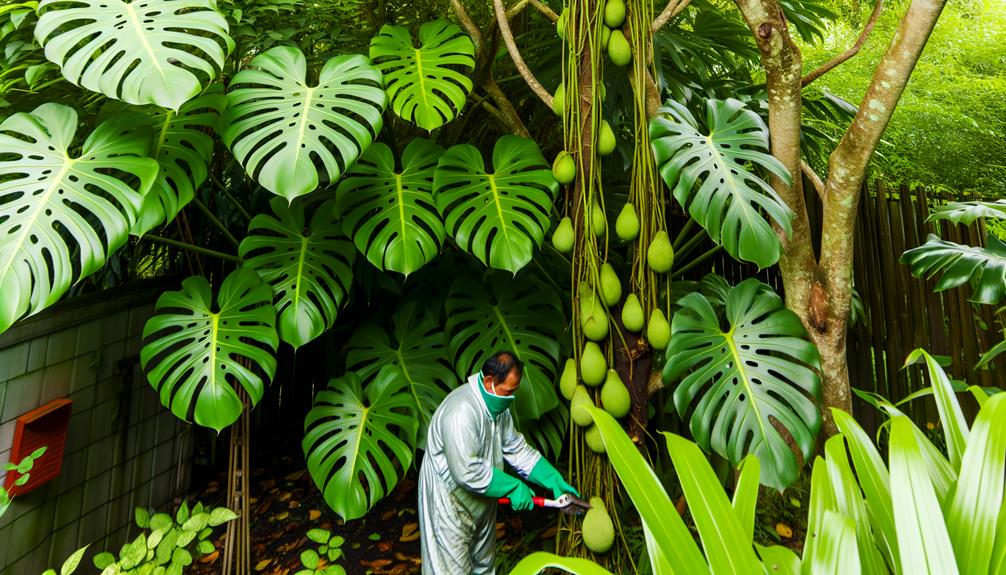How to Harvest Monstera Deliciosa
To harvest Monstera Deliciosa, first identify ripe fruit by looking for a uniformly green exterior with slightly loosened scales and a subtle aroma. Best conditions include temperatures between 75-85°F and 60-80% humidity.
Use sharp pruning shears and gloves for safety. Harvest early in the morning to avoid extreme weather.
Handle the fruit carefully, wearing gloves and using sanitized tools. Store the fruit at 50-55°F with 85-90% humidity for prime ripening.
Ripe fruit should yield slightly under pressure. Monitoring these parameters ensures top-notch fruit quality.
Learn more about the handling and culinary uses of Monstera Deliciosa for best practices.

Key Takeaways
- Identify ripe Monstera fruit by its uniformly green exterior with slightly loosened scales and a subtle aroma.
- Use sharp, sanitized pruning shears and wear gloves for protection while harvesting.
- Harvest early in the morning when temperatures are between 75-85°F and humidity levels are 60-80%.
- Handle fruit carefully, avoiding damage, and transport in a harvesting basket.
- Store harvested fruit at 50-55°F with 85-90% humidity to prevent spoilage and extend shelf life.
Recognizing Ripe Monstera Fruit
To recognize ripe Monstera fruit, look for a uniformly green exterior with slightly loosened scales. Inspect the fruit closely; the scales should start to separate but not fall off entirely. You'll notice a subtle aroma, indicating ripeness. Feel the fruit gently—ripe Monstera should yield slightly under pressure without being too soft.
Check the length as well; typically, a ripe Monstera measures around 8-12 inches. Observe the fruit's color consistency; any significant yellowing or browning suggests overripeness or spoilage. Make sure you avoid fruits with visible damage or mold.
Ideal Harvesting Conditions
Best harvesting conditions for Monstera deliciosa require a balance of temperature, humidity, and timing to guarantee peak flavor and quality. Aim for a consistent temperature between 75-85°F (24-29°C) to mimic the plant's natural tropical environment.
Maintain humidity levels around 60-80% to keep the fruit's skin from drying out prematurely. Monitor the fruit closely; it should be partially yellow-green and emit a sweet aroma, indicating ripeness. Harvest early in the morning when the plant's moisture levels are at their peak.
Avoid harvesting during extreme weather conditions, such as heatwaves or cold snaps, as these can negatively impact fruit quality. By adhering to these parameters, you'll optimize the Monstera deliciosa fruit reaches its full potential in flavor and texture.
Necessary Tools and Equipment
Having established ideal harvesting conditions, gather the necessary tools and equipment to guarantee a smooth and efficient process. Precision and care are paramount when dealing with Monstera Deliciosa, and using the right tools will prevent damage to the plant and fruit.
Here's a list of essential items you'll need:
- Sharp Pruning Shears: Make sure they're clean and sharp to make precise cuts and minimize plant stress.
- Gloves: Protect your hands from the plant's potential irritants and provide a better grip.
- Sanitizer: Use it to clean your tools before and after use to prevent disease transmission.
- Harvesting Basket: A sturdy, ventilated basket helps transport the fruit without causing bruising or damage.
These items will streamline your harvesting process.
Step-by-Step Harvesting Process
To begin the harvesting process, you'll need to identify ripe Monstera Deliciosa fruit, which shows a distinctive color change.
Use proper tools like a sharp knife or pruning shears to make clean cuts.
Handle the fruit carefully to avoid bruising and make sure its quality remains intact.
Identify Ripe Fruit
Look for a yellowing, slightly soft exterior with a sweet aroma to identify a ripe Monstera deliciosa fruit. You'll need to assess several indicators to ensure prime ripeness.
- Color: Check if the fruit has shifted from green to a yellowish hue.
- Texture: Gently press the exterior; it should yield slightly under pressure but not be overly mushy.
- Aroma: Smell the fruit. A ripe Monstera deliciosa emits a sweet, tropical fragrance.
- Scales: Observe the fruit's scales. They should begin to loosen and lift away from the flesh.
Use Proper Tools
Make certain you have the right tools on hand, such as a sharp knife or pruning shears, to cleanly detach the fruit from the plant. A sharp blade guarantees a precise cut, minimizing damage to both the fruit and the plant.
Inspect your tools to verify they're clean and free from rust. Sterilize them using rubbing alcohol or a diluted bleach solution to prevent potential contamination or disease transmission.
Position the blade at the base of the fruit, where it connects to the stem. Apply firm, steady pressure to make a clean cut. Avoid sawing motions, which can cause unnecessary bruising.
Immediately after cutting, place the fruit in a clean container to maintain its quality.
Handle With Care
When harvesting Monstera Deliciosa, gently grasp the fruit to avoid bruising or damaging its delicate surface. Follow these steps for a careful and efficient process:
- Inspect the Fruit: Verify the fruit is mature with a noticeable fragrance and the first few scales lifting slightly.
- Cut the Stem: Use sanitized, sharp pruning shears to cut the stem about an inch above the fruit.
- Cradle the Fruit: Support the fruit with your other hand to prevent it from falling and getting damaged.
- Transport Properly: Place the harvested fruit in a padded container to minimize movement and reduce the risk of bruising during transport.
Handle each fruit with the utmost care to maintain its quality and flavor.
Handling the Fruit Safely
To handle Monstera deliciosa fruit safely, make certain you wear gloves to protect against its potentially irritating calcium oxalate crystals. These crystals can cause skin irritation, so gloves are essential. Use clean, sharp tools to cut the fruit, minimizing damage that can release more irritants. Avoid touching your face or eyes during the process.
Once you've cut the fruit, place it on a clean surface. Inspect it for any signs of damage or decay. If any part of the fruit appears discolored or soft, discard it immediately to prevent contamination.
Wash your hands thoroughly after handling the fruit, even if you wore gloves. This guarantees you remove any residue that might still be present, maintaining safety.
Ripening Process Post-Harvest
After safely handling and inspecting your Monstera deliciosa fruit, understanding the ripening process post-harvest is key to ensuring top-notch flavor and texture. Here's a precise guide for best ripening:
- Temperature: Maintain a consistent temperature around 65°F to 75°F. Fluctuations can delay ripening.
- Humidity: Keep humidity levels between 70-90%. Insufficient humidity can cause uneven ripening.
- Air Circulation: Guarantee good air circulation to prevent mold growth. Stagnant air can compromise fruit quality.
- Ethylene Exposure: Store the fruit away from ethylene-producing fruits like apples and bananas to avoid premature ripening.
Signs of Overripe Fruit
Identifying overripe Monstera deliciosa fruit involves checking for a mushy texture, off-putting odor, and discoloration. When you touch the fruit, it should feel firm yet slightly yielding. If it feels excessively soft or mushy, it's past its prime.
The smell is another indicator; a ripe Monstera deliciosa should emit a pleasant, fruity aroma. An overripe one, however, will have a sour or fermented smell. Discoloration is also a key sign; look for dark or brown patches that indicate decay.
Additionally, the scales should fall off easily when the fruit is ready. If they detach too quickly or the underlying flesh appears excessively dark, the fruit is overripe. Accurate identification assures you enjoy the fruit at its best.
Storing Monstera Fruit
To store Monstera fruit effectively, you'll need to maintain a peak temperature of 10-12°C. This prevents spoilage and helps extend the fruit's shelf life.
Monitor humidity levels closely to avoid mold development and guarantee freshness.
Optimal Storage Temperature
Maintaining an ideal storage temperature of 50-55°F is important for preserving the quality and extending the shelf life of Monstera deliciosa fruit.
To achieve best results, follow these steps:
- Monitor Temperature: Use a reliable thermometer to regularly check the storage environment. Consistent temperature guarantees the fruit remains fresh.
- Humidity Control: Maintain a humidity level between 85-90%. This prevents dehydration and preserves the fruit's texture.
- Ventilation: Ensure proper air circulation to prevent ethylene gas buildup, which can accelerate ripening.
- Avoid Direct Sunlight: Store the fruit in a dark, cool place away from direct sunlight to prevent premature ripening.
Preventing Fruit Spoilage
Ensuring the proper storage conditions is critical, but you must also implement strategies to prevent fruit spoilage and maintain the quality of Monstera deliciosa.
First, inspect the fruit for any signs of damage or over-ripeness before storage. Damaged areas can accelerate spoilage.
Store the fruit in a well-ventilated container to allow for air circulation, which reduces mold growth. Avoid stacking fruits; instead, place them in a single layer to minimize pressure points that can cause bruising.
Maintain a relative humidity of around 85-90% to prevent dehydration while avoiding excessive moisture, which can lead to rot.
Check stored fruits regularly for early signs of spoilage, and remove any affected items immediately to prevent spreading.
Shelf Life Extension
Regularly monitoring the storage environment is crucial for extending the shelf life of Monstera deliciosa fruit. You should focus on four key factors to optimize conditions:
- Temperature: Maintain a consistent temperature between 50-55°F (10-13°C) to slow down ripening.
- Humidity: Keep humidity levels around 85-90% to prevent the fruit from drying out.
- Ventilation: Guarantee proper airflow to avoid mold growth and ethylene accumulation, which accelerates ripening.
- Storage Medium: Store the fruit in perforated plastic bags or breathable containers to balance moisture retention and air circulation.
Preparing Monstera for Eating
To prepare Monstera deliciosa for eating, start by inspecting the fruit for any signs of ripeness, characterized by the loosening of the hexagonal scales. Gently remove the scales, as this indicates the flesh underneath is ready for consumption.
Use a sharp knife to peel off any remaining scales that resist easy removal. Next, slice the fruit lengthwise, exposing the edible flesh. Carefully separate the flesh from the central core, avoiding any unripe sections which can cause irritation.
Rinse the flesh under cold water to make sure it's clean and free of any residue. Pat the flesh dry with a clean towel. Confirm you've removed all inedible parts before consuming. This method guarantees you'll enjoy the Monstera deliciosa safely.
Culinary Uses of Monstera Fruit
To maximize the culinary potential of Monstera fruit, guarantee you prepare it correctly by removing the inedible parts.
You'll appreciate its unique flavor profile, which combines pineapple and banana notes, along with its rich nutritional value.
Incorporating it into your diet can enhance various dishes while providing essential vitamins and minerals.
Preparing Monstera Fruit
When preparing Monstera deliciosa fruit for culinary uses, make certain it's fully ripe to avoid potential irritation from its high oxalate content.
Follow these precise steps for best preparation:
- Inspect Ripeness: Verify the scales are falling off, indicating the fruit is ripe and safe to consume.
- Peel Methodically: Gently peel away the scales to reveal the edible flesh underneath.
- Segment Extraction: Slice the fruit into manageable segments, avoiding the tough core.
- Clean Thoroughly: Rinse the fruit under running water to eliminate any remaining oxalate crystals.
Flavor and Nutritional Value
Properly prepared Monstera deliciosa fruit offers a unique flavor profile reminiscent of a blend between pineapple and banana, with significant nutritional benefits. You'll find it rich in vitamin C, aiding immune function, and potassium, essential for cardiovascular health.
The fruit also contains dietary fiber, promoting digestive health. When using it culinarily, make sure the fruit is fully ripened to avoid any potential irritation from calcium oxalates. Incorporate it into smoothies, salsas, or desserts for a tropical twist.
Additionally, its antioxidant properties help combat oxidative stress, promoting overall well-being. By understanding these elements, you can maximize both the flavor and health benefits of Monstera deliciosa, making it a valuable addition to your culinary repertoire.
Conclusion
To sum up, you've now mastered the intricate process of harvesting Monstera deliciosa. By recognizing ripe fruit, using the right tools, and following step-by-step guidelines, you guarantee a safe and effective harvest.
Remember, storing and preparing the fruit properly is key to enjoying its unique flavors. Don't let it become overripe—think of it like a delicate vintage record needing careful handling.
With this knowledge, you're well-equipped to savor the culinary delights of Monstera fruit.






